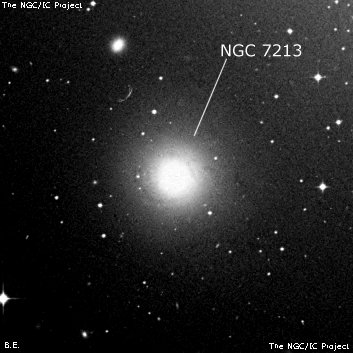
John Herschel discovered NGC 7213 = h3924 on 30 Sep 1834 and recorded "vB; R; gbM; 45"." His single position is accurate. NGC 7213 is the brightest in a group that includes NGCs 7232 and 7233, IC 5170 and IC 5181. The latter two galaxies were discovered by Joseph Lunt at the Royal Observatory at the Cape of Good Hope. Curiously, his list of new nebula also appears to include NGC 7213 (based on his position), though he specifically mentioned the new nebulae were near h3924 [NGC 7213].
200/250mm - 11" (8/8/04 - Haleakala Crater, Hawaii): fairly bright, moderately large, round, 1.5' diameter, increases to a small bright core. Very symmetrical appearance. Easy to locate 16' SE of mag 1.7 Alpha Gruis. Forms the western vertex of an isosceles triangle with two mag 10.5 stars ~6' E and SE.
300/350mm - 13.1" (7/20/85): fairly faint, small, bright core.
13.1" (9/11/82): faint, small, round. Located 16' SE of Alpha Gruis (V = 1.7). This is farthest southern galaxy observed from northern California.
400/500mm - 18" (11/22/08): fairly bright [even from northern California!], moderately large, round, 1.5' diameter. Contains a bright 30" core that gradually increases to the center and a much fainter outer halo.
18" (7/5/05 - Magellan Observatory, Australia): bright, moderately large, round, 1.8' diameter. Well concentrated with a small bright core that increases to a very bright stellar nucleus. Forms the western vertex of an acute isosceles triangle with two equal mag 10.5 stars 6' E and 6' SE. Located 16' SE of mag 1.7 Alpha Gruis (Al Nair).
Notes by Steve Gottlieb